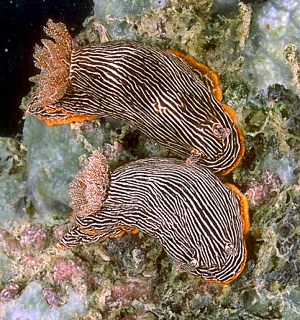
Chromodoris lineolata
(van Hasselt, 1824)
Order: NUDIBRANCHIA
Suborder: DORIDINA
Family: Chromodorididae
DISTRIBUTION
Tropical Indo-West Pacific
PHOTO
Darwin, Northern Territory, June 1987.
UPPER: on food sponge, Dysidea sp..
LOWER RIGHT: juvenile animal.
LOWER LEFT: adult.
PHOTOS: Bill Rudman.
Grows to about 30mm long. mantle pattern is essentially black with fine opaque white longitudinal lines, and a broad orange or yellow border. Characteristically there is a black line adjacent to the inner edge of the orange border. This enables the species to be readily distinguishable from the similarly coloured Chromodoris striatella in which there is a white line adjacent to the inner edge of the orange border. I have found it feeding on sponges of the genera Dysidea and Spongia.
References:
• Rudman, W.B. (1982) The Chromodorididae (Opisthobranchia: Mollusca) of the Indo-West Pacific: Chromodoris quadricolor, C. lineolata and Hypselodoris nigrolineata colour groups. Zoological Journal of the Linnean Society, 76: 183-241.
• Rudman, W.B., Darvell, B.W. (1990) Opisthobranch Molluscs of Hong Kong: Part 1. Nudibranch Families; Goniodorididae, Onchidorididae, Triophidae, Gymnodorididae, Chromodorididae (Nudibranchia). Asian Marine Biology, 7: 31-79.
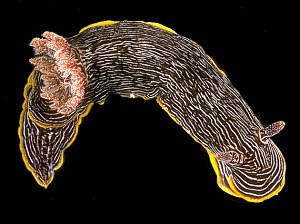
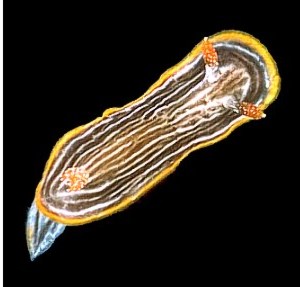
Rudman, W.B., 1999 (June 19) Chromodoris lineolata (van Hasselt, 1824). [In] Sea Slug Forum. Australian Museum, Sydney. Available from http://www.seaslugforum.net/find/chroline
Related messages
Chromodoris lineolata - feeding record
January 25, 2007
From: Bill Rudman
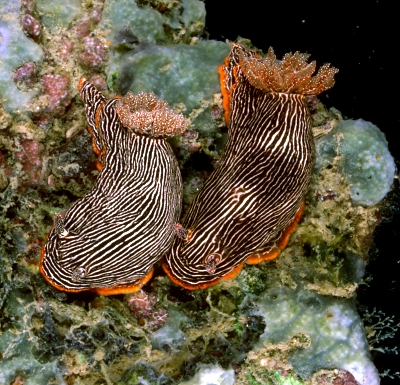
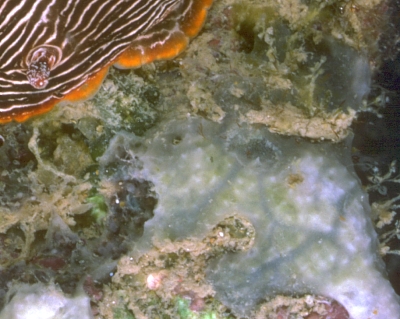
I have a photo of this group of Chromodoris lineolata in the species Fact Sheet, but have not actually included a message with details.
These are two of a group of adults and juveniles I found in an intertidal pool in Darwin, feeding on a sponge which was identified at the time by Dr John Hooper as Dysidea herbacea. It is now known as Lamellodysidea herbacea. This Chromodoris is one of a very few species of the genus which feed on dysideid sponges. In the upper photo the whole central area has been eaten by the slugs. In the lower photo large 'bite marks' can be seen on the left side of the sponge colony.
Locality: East Point, Darwin, in intertidal pool. Northern Territory, Australia. 29 June 1987. [47, 40, 38, 38, 5, 6 mm long alive]. AM C153614. Photos: Bill Rudman.
Bill Rudman
Rudman, W.B., 2007 (Jan 25) Chromodoris lineolata - feeding record. [Message in] Sea Slug Forum. Australian Museum, Sydney. Available from http://www.seaslugforum.net/find/19136Chromodoris lineolata? from Japan
May 15, 2003
From: Toshihiro Horiuchi
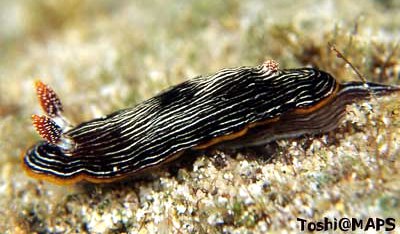
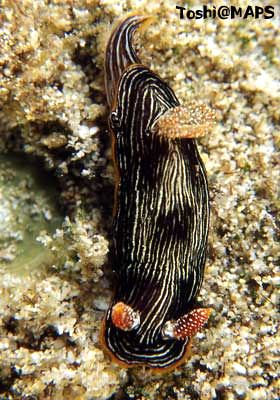
Dear Bill,
I found this chromodorid at Amami Ohshima Island, Kogoshima, Japan. I found it in shallow water at Kurasaki Beach on rock.
I think that probably it is C. lineolata, but it may be C. striatella. Could you help me to identify this?
Date: March 2003
Water temperature: 19 degrees
Depth: 5m
Size: about 15mm.
Best regards,
Toshihiro Horiuchi
YRB00514@nifty.ne.jp
Horiuchi, T., 2003 (May 15) Chromodoris lineolata? from Japan. [Message in] Sea Slug Forum. Australian Museum, Sydney. Available from http://www.seaslugforum.net/find/9894Dear Toshihiro,
I agree that this is most probably C. lineolata rather than C. striatella. C. lineolata and C. striatella can usually be easily differentiated by the colour directly inside the orange mantle margin, - black in C. lineolata and translucent white in C. striatella. However in your animal there is a very noticeable pattern of 5 blackish patches between the gills and the rhinophores which is very characteristic of C. striatella. We may discover that the two are just forms of one species, but at present I would call your animal C. lineolata.
Best wishes,
Bill Rudman
Chromodoris lineolata from Hong Kong
January 27, 2002
From: Bill Rudman & Brian Darvell
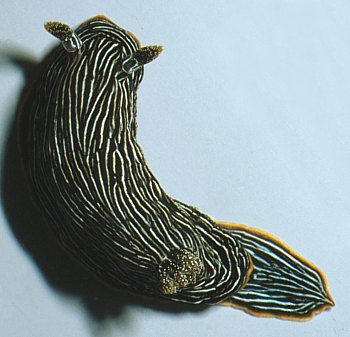
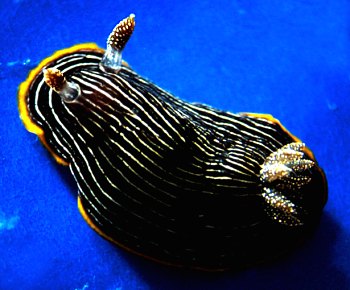
Here is some information and photos on Chromodoris lineolata from Brian Darvell's Hong Kong collections.
One of a number of very similarly coloured species found in the Indo-West Pacific (Rudman 1982) two of which are known to occur in Hong Kong. Chromodoris lineolata can best be described as black with narrow heavily pigmented longitudinal white lines. The edge of the mantle has an orange border and usually the inside edge of the orange border is alongside a black rather than a white line. Both the gills and the rhinophores are blackish, often with a reddish tinge, and spotted with white.
It is very similar in colour to C. striatella, but the distinctly pigmented white lines and the black line alongside the orange border are characteristic of the species. It grows to 50 mm in length.
PHOTO:
Upper: AM C153325, 25 March 1987, Site 7.50, Wu Kai Sha, Tolo Harbour, intertidal. Depth range: 0-10 m, Hong Kong. Lower: AM C133724, 4 specimens, 23 March 1982, Site 7.25, Hoi Sing. Wan, Tolo Harbour, intertidal, Hong Kong. Photos: Brian Darvell.
Hong Kong Collection Records:
AM C133724, 4 specimens, 23 March 1982, Site 7.25, Hoi Sing. Wan, Tolo Harbour, intertidal. AM C150352, 3 specimens, 4-20 April 1986, Tolo Harbour, Mirs Bay. AM C153325, 25 March 1987, Site 7.50, Wu Kai Sha, Tolo Harbour, intertidal. Depth range: 0-10 m.
Reference:
• Rudman, W.B. & Darvell, B.W. (1990) Opisthobranch molluscs of Hong Kong. Part 1. Goniodorididae, Onchidorididae, Triophidae, Gymnodorididae, Chromodorididae, (Nudibranchia). Asian Marine Biology, 7: 31-79
Best wishes,
Bill Rudman & Brian Darvell
